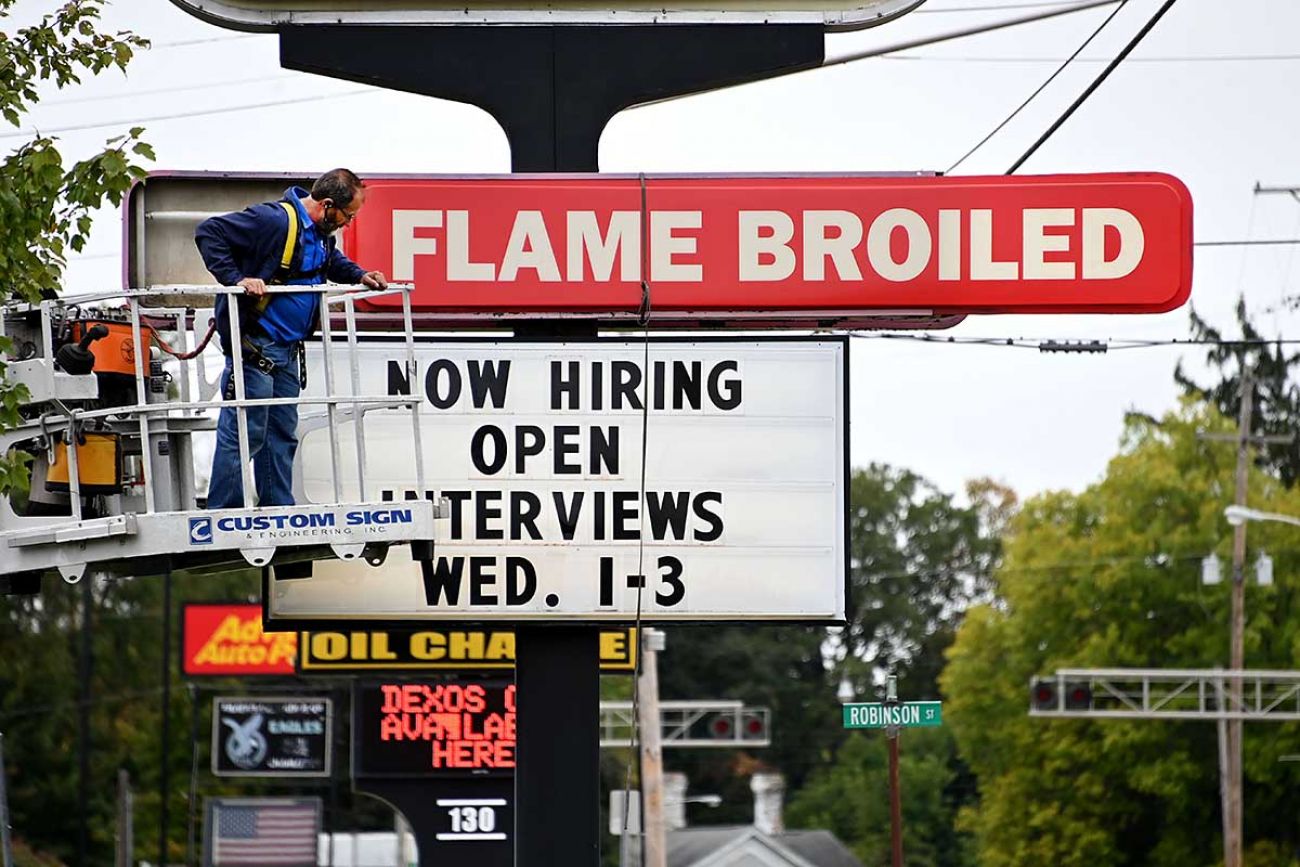‘Labor shortages are not going away’ in Michigan. Is automation the answer?

Michigan employers got a sign this month that the labor shortage that has left many scrambling to fill positions — and raise wages to attract workers — is improving, just in time for holiday hiring.
Still more hires are expected over the next few months, based on the last two months’ of national jobs data, which shows some workers slowly choosing to return to work.
However, global economists warn the competition for workers, particularly lower-wage hourly positions, is no longer a pandemic or a local issue. Instead, it’s forecast to last for years.
Related:
- Child care as economic development? You bet. $1.4B in aid coming to Michigan
- Rising wages, few workers: A small town in Michigan adjusts to the new economy
“Overall, labor shortages are not going away,” said Gad Levanson, senior economist with The Conference Board, a nonprofit business research group, during a global economic forecast presentation on Nov. 3.
Michigan already has been worried about that. Gov. Gretchen Whitmer’s MI New Economy initiative identified the worker shortage as one of the state’s biggest economic challenges, along with too-many low-wage jobs.
Keith Lambert sees the effects in greater Lansing, where he is vice president of business attraction at the Lansing Economic Area Partnership economic development group. He is trying to bring new jobs to Eaton, Clinton and Ingham Counties, while assisting local employers to grow.
However, that effort is taking place while the state’s workforce of 4.73 million has 190,000 fewer workers than in February 2020. Businesses from restaurants and retail to manufacturing and distribution companies are “struggling to find people to work for them,” Lambert said.
In towns like Charlotte, southwest of Lansing, that’s left locally owned businesses to struggle against the regional corporate businesses that can more easily raise wages to attract workers to that area of Eaton County.
And it raises concerns for the state as Michigan tries to lure large-scale development projects to add higher-paying jobs.
“If and when we’re to land (them), there’s going to be more pressure, more intensity about … how to make projects like that successful and have the talent to connect to those jobs,” Lambert told Bridge Michigan.
The workforce shrunk nationwide during the pandemic, as older workers opted for early retirement and younger workers became more selective about jobs, Levanson said.
Nationwide, nearly 30 million Baby Boomers left the workforce in the third quarter of 2020, while surveys since then show as many as 75 percent of older workers plan to retire early.
“We have essentially no growth in the working age population for the first time in U.S. history,” Levanson said.
In 2000, the median age of a worker in the United States was 39. By 2020, the median age climbed to 42. And by 2030, the median age will be on the verge of 43.
The situation is acute in Michigan: The median age is 50 in 21 of 83 counties, the most counties of any state in the nation that is over the threshold. Overall, Michigan is the 12th oldest state in the nation.
Other challenges for Michigan include:
- Michigan’s labor force participation has trailed the nation since December 2001.
- Deaths in the state are expected to begin to outpace births starting in 2030.
- Population growth fell to the second-slowest rate in the nation, according to the U.S. Census. With 10,077,331 residents, Michigan is now the 10th most populous state, down from its eighth in 2010, passed by Georgia and North Carolina.
In a labor force with fewer workers, boosting educational attainment and technological skills offer a chance to grow through innovation and efficiency gains, said Dana M. Peterson, chief economist of the Conference Board.
She noted that the labor force is also dwindling in Japan, western Europe, Australia and China — even as competition intensifies competition from India and sub-Saharan Africa.
State officials already are focusing on “upskilling” the existing workforce.
“One of the main concerns we continue to hear from business leaders and employers of all shapes and sizes is that there aren’t enough workers with the skills they need to fill critical vacancies,” Susan Corbin, director of the Michigan Department of Labor and Economic Opportunity, told Bridge, pointing to the $722 million budget recommendation to increase funding for post-secondary work skills education.
That investment, if approved, “will address our state’s skills gap and workforce challenges by providing opportunities for Michiganders to get access to the skills, credentials, apprenticeships and degrees that businesses need while providing a clear path into a good into a good paying career for workers.”
To remain competitive, Michigan small manufacturers should invest in Industry 4.0 automation and increasing flexibility for their workers, said Tom Kelly, CEO of Automation Alley. The nonprofit, based in Oakland County, advocates for more technology in manufacturing.
“Manufacturing has always had a worker deficit,” Kelly told Bridge. “That worker deficit got exacerbated by COVID and is going to continue to get worse. So you have no choice but to automate.”
Instead, Kelly said, “they're using the same playbook that they’ve always used.”
And the risk to them, as they try to hire unskilled workers at low rates, is that “those people that you need to do these jobs aren't coming back.”
Kelly said he’s trying to convince many small- to mid-size manufacturers to turn to robotics.
Prices have dropped and may cost tens of thousands less than hiring a full-time worker. With a robot, another worker may be able to accomplish the equivalent of two jobs — and the manufacturer will be able to maintain or increase production, and likely pay their workers more because of the additional skills needed to work in the higher-tech setting.
Beyond investing in equipment, Kelly said, employers need to recognize that they’re competing for workers with technology — in the form of apps like Lyft and Shipt. Creating flexible work could offer paybacks in a more stable labor force, he said, even if 40 part-timers do the work of 10 full-time employees.
“For the low-skilled worker, their attitudes have changed,” Kelly said. “Technology has taught them that they can jump in and out of the workforce whenever they want.
“Management needs to be thinking differently about how they solve the problem.”
Among employers embracing that concept for workers is delivery giant Amazon, Kelly noted, with the “Amazon Anytime” app-based shifts. The company employs 21,000 in Michigan, said spokesperson Jessica Pawl.

Amazon is offering sign-on bonuses of $3,000 in some Michigan locations to stay ahead of the competition for workers. Starting pay nationwide averages $18.
“Amazon is hiring people left and right,” said Lambert, the Lansing economic development director.
And more jobs are coming — including to a new 1 million-square-foot fulfillment center that will open in 2022 in Delta Township, a 20-minute drive from Charlotte.
But even today’s staffing won’t be all Amazon needs — or the end to the regional hiring competition.
Lambert said the company then will need 500 more people to work. “So we expect the pressure to continue to be there.”
Economists are closely watching how pay increases play out. In the third quarter they set a 20-year record in the U.S., prompting concerns that inflation — which is also due to supply shortages, in addition to labor — will prompt an interest rate hike to cool the economy.
Ongoing rapid wage growth into 2022, economist Levanson said, is “the more concerning problem.”
Even so, the national economy should increase 2 percent annually through 2031, despite lingering questions about the labor market and inflation, said Peterson from the Conference Board.
Business Watch
Covering the intersection of business and policy, and informing Michigan employers and workers on the long road back from coronavirus.
- About Business Watch
- Subscribe
- Share tips and questions with Bridge Business Editor Paula Gardner
Thanks to our Business Watch sponsors.
Support Bridge's nonprofit civic journalism. Donate today.
See what new members are saying about why they donated to Bridge Michigan:
- “In order for this information to be accurate and unbiased it must be underwritten by its readers, not by special interests.” - Larry S.
- “Not many other media sources report on the topics Bridge does.” - Susan B.
- “Your journalism is outstanding and rare these days.” - Mark S.
If you want to ensure the future of nonpartisan, nonprofit Michigan journalism, please become a member today. You, too, will be asked why you donated and maybe we'll feature your quote next time!




